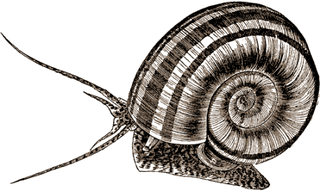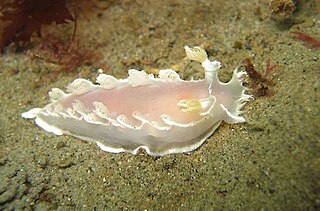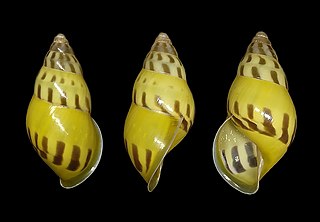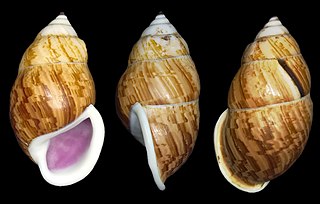
Conchology is the study of mollusc shells. Conchology is one aspect of malacology, the study of molluscs; however, malacology is the study of molluscs as whole organisms, whereas conchology is confined to the study of their shells. It includes the study of land and freshwater mollusc shells as well as seashells and extends to the study of a gastropod's operculum.

Marisa cornuarietis, common name the Colombian ramshorn apple snail, is a species of large freshwater snail with an operculum, an aquatic gastropod mollusc in the family Ampullariidae, the apple snail family.

Tritoniidae is a taxonomic family of nudibranchs in the suborder Cladobranchia, shell-less marine gastropod molluscs. This family includes some of the largest known nudibranchs, with the NE Atlantic species Tritonia hombergii reaching 20 cm in length. It is the only family in the monotypic superfamily Tritonioidea.
Planogyra astericus, common name the eastern flat-whorl, is a species of small air-breathing land snail, a terrestrial pulmonate gastropod mollusk in the family Valloniidae.

Mollusca is the second-largest phylum of invertebrate animals, after Arthropoda; members are known as molluscs or mollusks. Around 76,000 extant species of molluscs are recognized. The number of fossil species is estimated between 60,000 and 100,000 additional species. The proportion of undescribed species is very high. Many taxa remain poorly studied.

Marisa is a genus of freshwater snails in the family Ampullariidae, the apple snails.
Planogyra is a genus of small air-breathing land snails, terrestrial pulmonate gastropod mollusks in the family Valloniidae.

Freshwater snails are gastropod mollusks that live in fresh water. There are many different families. They are found throughout the world in various habitats, ranging from ephemeral pools to the largest lakes, and from small seeps and springs to major rivers. The great majority of freshwater gastropods have a shell, with very few exceptions. Some groups of snails that live in freshwater respire using gills, whereas other groups need to reach the surface to breathe air. In addition, some are amphibious and have both gills and a lung. Most feed on algae, but many are detritivores and some are filter feeders.
Calliostoma mcleani, common name McLean's calliostoma, is a species of sea snail, a marine gastropod mollusk in the family Calliostomatidae.
Pomacea baeri is a South American species of freshwater snail with gills and an operculum, an aquatic gastropod mollusc in the family Ampullariidae, the apple snails.

Amphidromus elvinae is a species of air-breathing land snail in the family Camaenidae.

Amphidromus jacobsoni is a species of air-breathing land snail, a terrestrial pulmonate gastropod mollusc in the family Camaenidae.

Amphidromus sumatranus is a species of air-breathing land snail, a terrestrial pulmonate gastropod mollusc in the family Camaenidae.

Amphidromus cambojiensis is a species of air-breathing land snail, a terrestrial pulmonate gastropod mollusc in the family Camaenidae.

Pomacea decussata is a species of freshwater snail in the family Ampullariidae.

Pomacea fasciata is a freshwater snail in the Ampullariidae family. It is located in Jamaica, Guadeloupe, and Hispaniola. It lays white eggs.











